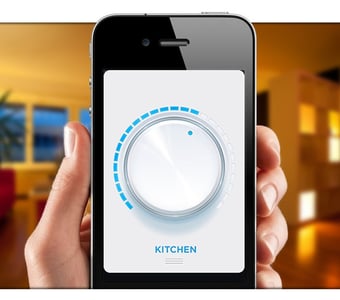Y ou come home after a long day of work. Hungry, thinking about leftover pizza, you say: Turn on oven to 180. Feeling slightly chilly, you say: Turn heat up to to 22. Then you ask, What TV shows are on now that I would like... only to hear a familiar voice tell you Top Gear is starting in 10 minutes. As you enter each room, the lights automatically come on to your desired night-time level and you throw yourself on to the inviting sofa.
ou come home after a long day of work. Hungry, thinking about leftover pizza, you say: Turn on oven to 180. Feeling slightly chilly, you say: Turn heat up to to 22. Then you ask, What TV shows are on now that I would like... only to hear a familiar voice tell you Top Gear is starting in 10 minutes. As you enter each room, the lights automatically come on to your desired night-time level and you throw yourself on to the inviting sofa.
You think to yourself how nice the modern home is.
This modern home is just around the corner and will be a product of the Internet of Things. The IoT is comprised of objects, like your oven, heating, guitar, phone system and lights, all connected to the internet and your home network. This means they can share data and be communicated with no matter where you are.
But the Internet of Things has always struck me as somewhat of a logistical nightmare given not all objects will be able to be hardwired to the internet, instead relying on WiFi—which is not a particularly strong connection for most of us. Most WiFi networks I am on can barely handle a few devices, let alone dozens.
Enter a new development from a team of computer scientists and electrical engineers at the University of Washington. They have developed an extremely power-efficient version of wireless networking technology that consumes 10,000 times less power than current Wi-Fi components, allowing Wi-Fi networking to be built into a much wider range of devices. Ah ha.
Passive Wi-Fi is, as the name suggests, partially passive—it takes in radio wave energy from an outside source and reflects that signal with its data added to it. Vamsi Talla, a UW electrical engineering doctoral student and co-author of the latest research, explained, "All the networking, heavy-lifting and power-consuming pieces are done by the one plugged-in device. The passive devices are only reflecting to generate the Wi-Fi packets, which is a really energy-efficient way to communicate."
Passive Wi-Fi is compatible with normal Wi-Fi, but it uses a separate base station to generate the radio signal for its backscatter-based devices. It's capable of handling data at speeds up to 11 megabits per second and has been tested to work at distances of over 100 feet.
Because backscatter communication only requires devices to use a tiny amount of power to modulate the reflected radio signal, Passive Wi-Fi could be used in devices that would typically use Bluetooth or another low-power wireless networking technology, with the added benefit of Wi-Fi security. It can also easily be integrated into IoT sensors and other devices, allowing them to talk directly to the cloud rather than depend on another device (such as a smartphone or PC) to act as an intermediary.
So what all this means is that the technological developments needed to support and connect the ‘Things’ part of the IoT, are happening. Your sofa is soon going to be able to know you are on it, or when your partner is. Your bed is going to be able to heat itself up automatically when the temperature goes below 5 degrees, and your in-house stereo is going to automatically lower the volume when you take a phone call. Even millennials will have to admit this is next level cool. Or, at least, next level.
About VTSL
VTSL is a technology company and telecoms carrier specialising in hosted business phone systems and unifed communications for orgainsations wanting to get ahead. VTSL's proprietary VOIP phone systems, one-number contactability solutions and high speed internet services are some of the reasons it is considered a leading UK communications company. For more information on VTSL's business phone systems, VoIP services, unified commnications and connectivity, email info@vtsl.net or call 020 7078 3200.

